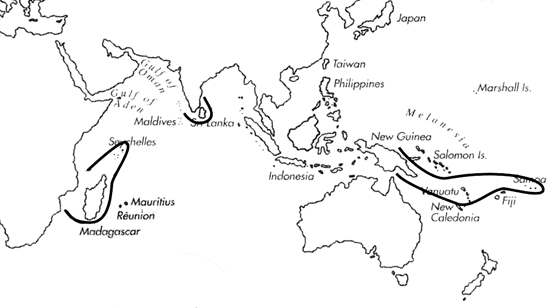Range: Indian Ocean: Mozambique, Madagascar, Seychelles, India, and Sri Lanka; Pacific: Papua New Guinea, Vanuatu, and Samoa.
Description: Medium-sized, moderately solid. Last whorl conoid-cylindrical, outline slightly convex. Aperture slightly wider at base than near shoulder. Shoulder angulate. Spire low, outline concave. Larval shell multispiral, maximum diameter about 0.7 mm. Teleoconch sutural ramps flat, with 1 increasing to 4-6 spiral grooves. Last whorl with closely spaced, narrow or wide spiral ribbons from base to shoulder; ribbons narrow at base and just below shoulder, often less pronounced adapically.
| Shell Morphometry | ||
|---|---|---|
| L | 35-54 mm | |
| RW | 0.12-0.30 g/mm | |
| (L 35-50 mm) | ||
| RD | 0.49-0.56 | |
| PMD | 0.77-0.82 | |
| RSH | 0.07-0.11 | |
Ground colour white clouded with violet. Last whorl with rows of alternating brown to blackish brown and white dashes and dots on the spiral ribbons, sometimes confined to the adapical portions of ribbons. A dark colour-pattern variant endemic to Vanuatu (Pl. 17, Fig. 4) has solid, dark brown lines on the spiral ribbons leaving only sparsely scattered ground-colour flecks. Apex immaculate greyish white. Later sutural ramps matching last whorl pattern in size, intensity and colour of the axially arranged markings. Aperture white to orange. In N. Papua New Guinea, dorsum of foot yellowish grey washed with tan, with a large orange semi-circle at anterior end that is overlaid with tan except for the anterior edge; a spotted tan pre-marginal line parallels lateral and posterior sides. Sole of foot pale yellow. Rostrum cream and tan. Tentacles white. Siphon reddish grey ventrally, grading to reddish brown dorsally, with dark brown spots behind the solid dark brown tip; spots denser toward dorsal side (Pl. 75, Fig. 31) (as "C. tenellus"; Chaberman, pers. comm., 1981). This description may, however, refer to C. artoptus that has sometimes been erroneously referred to as "C. tenellus Holten" (see Estival, 1981).
Habitat and Habits: From the infralittoral fringe to about 60 m. In Mozambique, on banks and flats of sand, often along narrow channels (Grosch, pers. comm., 1989); in Vanuatu, on muddy bottoms in 3-6 m (Estival, 1981).
Discussion: C. nimbosus cannot be confused with any of its congeners.

C. nimbosus range map
This section contains verbatim reproductions of the accounts of 316 species of Conus from the Indo-Pacific region, from Manual of the Living Conidae, by Röckel, Korn and Kohn (1995). They are reproduced with the kind permission of the present publisher, Conchbooks.
All plates and figures referred to in the text are also in Röckel, Korn & Kohn, 1995. Manual of the Living Conidae Vol. 1: Indo-Pacific Region.
The range maps have been modified so that each species account has it own map, rather than one map that showed the ranges of several species in the original work. This was necessary because each species account is on a separate page on the website and not confined to the order of accounts in the book.